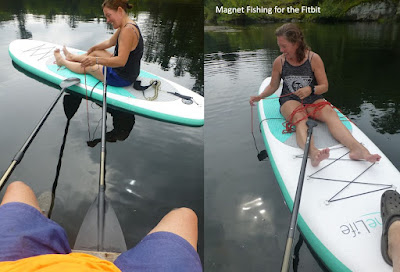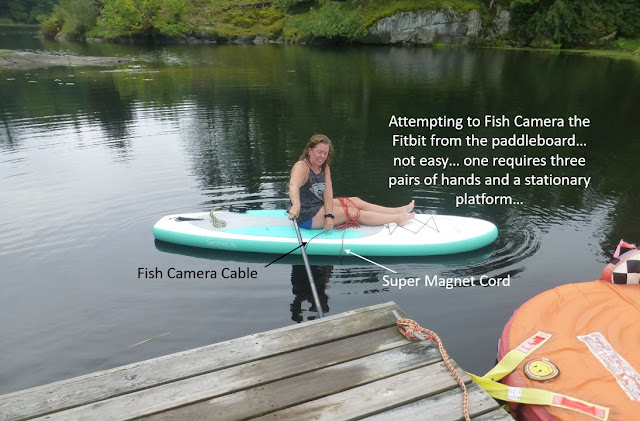 |
| Dick Tracy's Watch was way ahead of its time |
The two-way radio watch became synonymous with hard-boiled detective Dick Tracy, the comic-strip super detective created by Chester Gould and active solving crimes from 1931 to 1977. Technology has changed a lot since Chester dreamt up his watch. Like smartphones, "smart watches" use touchscreens, offer apps, and often record your heart rate and other vital signs. In 2024, 224.31 million (that is a lot of people) worldwide use Smart Watches. More than 24% of suburbanites brandish them on their wrists. Chester was indeed way ahead of his time and his comic book fiction evolved into a popular fact.
My Fitbit has a GPS, 3-axis accelerometer, optical heart rate monitor, vibration motor, red and infrared sensors for blood oxygen (SpO2) monitoring and an ambient light sensor. My Fitbit tracked my steps, distance travelled, calories burned, heart rate, monitored my sleep, connected to my phone, and received calls, texts and emails. It had become an important part of my busy life and could even tell the time. Despite all of these capabilities, "Dick" could not swim! We had to save "Dick Tracy" but how in twenty feet of water?
We began researching how long a "Fitbit Sense 2" could survive underwater. Fitbit advertises it can easily survive up to 50 meters (164 feet) of depth. So depth was not a problem! The waterproof seals on wearables typically have around a two-year lifespan. Time was also on our side although "Dick" was a year and a half old and thus pushing the age limit.
Some sites suggested that a submerged Smart Watch could last "quite a while", so we started planning the Fitbit Recovery Project, FRP. Other sources advised that any recovery was quite impossible so just give up before you start... We couldn't find any success stories online, but that didn’t stop us. It would be an adventure in any case.
We started with heavy-duty magnets attached to ropes and buoys. The thinking was that there was enough metal in the Fitbit to be attracted to a magnet - especially an industrial welding magnet or one designed specifically for retrieving metal objects. It seemed like a good idea and success could surely not take very long.
We "magnet-fished" from the paddle boards and "Super Mable", gently drifting around in the swimming hole for a few days. We hoped to feel the clunk of "Dick" being drawn magnetically in for the rescue. Unfortunately, nothing except a few historic bottle caps were recovered.
Maybe there was not enough metal in the Fitbit? We could guess where the Fitbit must be on the bottom so perhaps a net would scoop it up. We attached fishing nets to long painting poles. To reach the required depth, two poles had to be joined together using the Handy Man secret adhesive - duct tape.
A rope was attached to the lip of the net. The netting technique required two people: one steering the pole-net assembly and the other pulling the rope attached to the lip of the net through the twenty feet of water. The rope ensured that the net could scoop at the bottom of the lake and then be pulled up for an examination of the content without spilling the valuable cargo. We caught mud, weeds and zebra mussel shells but no "Dick". Just like in the movie "Jaws", we needed a bigger net! Success would certainly follow. We constructed a much larger drag net using a badminton net, chains, and flotation. The concept was based on a fishing seine. The chains tied to the bottom of the net would scour the muddy bottom. Long wooden straps would keep the net fully extended while providing floatation for the top of the seine.Operationally, someone paddled the seine badminton net out to the far side of the pool with the apparatus carefully arranged. Deployment required the assembly to drop in sequence so the chain side landed on the bottom. Two people spread apart on the dock would then pull the seine across the bottom capturing "Dick" in the process. Success was almost guaranteed.
We tried four sweeps across the pool toward the dock catching only weeds. Perhaps we needed to pull the net in the other direction in order to ensure success. "Dick" might have moved through our previous efforts.
We migrated the seine operation to the other rocky peninsula. The net was pulled across the swimming area from the floating dock. Surely "Dick" was almost within our grasp! All we saw was a large bass.
Magnets and two styles of nets had proved to be ineffective. Perhaps we had moved "Dick" back and forth across the swimming area. We really had no idea where to look next. It was time for technology.
Things took a positive turn when my uncle arrived with his fishing camera. It had not been used for a while but might just be the answer! After charging the battery, it did not take long for technology and science to prove its worth. With the camera, we could actually see the watch sitting placidly on the bottom of the deep pool, clear as day. The fish camera had an LED light that showed "Dick" to be face down with the vinyl straps curved upward. We could see "Dick" but how could we rescue him? We even tried a night-time rescue thinking that the fluorescent display of "Dick" would make it easier to see and thus snag the watch. It turned out that all the fish camera could see were whiskered bullheads attracted to the LED lighting and coming in for fishy "selfies". Hmmm... the evening mosquitoes were also very hungry and quickly encouraged the FRP Team to abandon that approach.
We even tried a night-time rescue thinking that the fluorescent display of "Dick" would make it easier to see and thus snag the watch. It turned out that all the fish camera could see were whiskered bullheads attracted to the LED lighting and coming in for fishy "selfies". Hmmm... the evening mosquitoes were also very hungry and quickly encouraged the FRP Team to abandon that approach.
My dad had an idea to move the pontoon boat to the end of the dock, using it to secure the camera on a painting roller rod to minimize movement. The camera had to be suspended a few inches off the bottom for a clear image. We tied the boat securely to the floating dock. The dock itself had to be further tethered to the steel anchors on the shore. Nothing was allowed to move as even getting onto the floating dock or the boat caused vertical motions and the loss of contact with the drowning "Dick".
On the morning of Day 9, we decided to try one last approach: a fishing rod with a weight and a large three-pronged treble hook. It was a last-ditch effort to save "Dick" as the summer holiday was ending the next day. My daughter and I had the watch on camera control and the TV screen while my dad dropped the hook in the pool and bounced it off the bottom.
It was tricky to locate and align the hook with the watch. Weather conditions were not ideal with the chilly rain and wind. After some experimentation to account for differences in the TV image and the reality of the real estate at the bottom of the lake, we suddenly saw the hook and the watch simultaneously on the TV screen. Olivia, my daughter, suggested, “Wait... just bounce the hook slowly toward the camera.” My dad did just that from twenty-five feet above. Each time the hook and sinker dropped to the bottom, a cloud of silt erupted obscuring the camera's view. Another three bounces and the sinker dropped right on "Dick". Oh no! The watch immediately disappeared again in an eruption of silt and mud!
We thought we had lost "Dick" for good this time, but when my Dad pulled the line, there it was—hooked and intact! We all yelled in excitement, and I may have let a few choice words slip. As my Dad carefully and slowly reeled in the line, I bent down, ready to grab the Fitbit. The watch was securely attached to the hook. This one was not getting away. We rushed up to the house to show Nana and Charlotte, the essential background support part of the FRP Team.
We were in shock. The watch was black and covered in dirt. But when I reached for it, it buzzed and lit up, displaying a low battery alarm! I removed the band and immediately submerged it in rice bath to dry "Dick" out - essentially an ICU for wet electronics. The rice was then fed to the birds.
Later that day, I charged it, and to my amazement, it synced perfectly with all my data from my phone. After 9 days and 20 feet underwater, the watch worked great. "Dick" was very much alive. The battery doesn’t last quite as long and his voice still sounds a bit nasally, but overall, "Dick Tracy" is as good as new!
We tested to see if one of the strong magnets could attract "Dick". The response was too weak to be effective so that method of recovery was essentially a waste of effort. The only chance for recovery except for prevailing on the diving abilities of Lloyd Bridges or Jacques Cousteau was simply a hook, line and sinker.
The FitBit Recovery Project (FRP) had turned out to be a success. Never give up... It took a five-person team to pull this off - not to mention the equipment and technology supplied by Uncle Jim.
In the future, just take your watches off before you dive into deep water...
Warmest regards and keep your paddle in the water,
Janice
















No comments:
Post a Comment